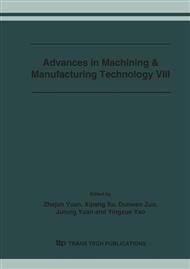p.169
p.174
p.180
p.185
p.190
p.195
p.200
p.205
p.210
Study on Surface Quality of Nano ZrO2 Ceramics in Grinding by the Aid of Ultrasonic Vibration
Abstract:
Nano ceramics possesses excellent mechanical property and physical characteristics in contrast to conventional engineering ceramics, so it has tremendous application prospect. Adopting ultrasonic composite processing we describe the influences of grinding speed, grinding depth, wheel granularity and no-spark grinding times on the surface roughness of nano ZrO2 ceramics. By means of SEM and AFM the surface character and critical ductile grinding depth of nano ZrO2 ceramics in the condition of conventional and ultrasonic grinding are also discussed. At last, the residual stress of surface and crystalline phase transformation under the condition of conventional grinding and ultrasonic vibration grinding were analyzed by X-ray diffraction. The research indicated that ultrasonic vibration grinding could obtain nano finished surface with high efficiency. The residual stress of nano ZrO2 ceramics surface is determined much by different grinding styles.
Info:
Periodical:
Pages:
190-194
Citation:
Online since:
July 2006
Authors:
Price:
Сopyright:
© 2006 Trans Tech Publications Ltd. All Rights Reserved
Share:
Citation:


